The National Child Nutrition Conference is officially underway! Monday was an exciting preconference day filled with invaluable sessions, networking opportunities, and in-depth discussions on child nutrition programs. Here’s a recap of the day’s events:
Read MoreDo CACFP operators need to provide one whole grain-rich grain per day when serving infants?
Read MoreToday, April 10th, two important CACFP bills were re-introduced in Congress. The Child Care Nutrition Enhancement Act and Early Childhood Nutrition Improvement work together to provide much-needed improvements for the CACFP and address challenges faced by CACFP operators.
Read MoreAs part of the Make America Healthy Again (MAHA) agenda, U.S. Secretary of Agriculture Brooke Rollins and U.S. Health and Human Services Secretary Robert F. Kennedy Jr. visited Ferdinand T. Day Elementary School in Alexandria, Virginia, to see the impact of child nutrition programs in action.
Read MoreAre edamame creditable in the CACFP?
Read MoreWe are pleased to share the exciting news that James (JC) Miller has joined the United States Department of Agriculture (USDA) as the new Administrator for Food and Nutrition Services (FNS), effective March 24th. With a wealth of experience in leadership across healthcare, nonprofit, and government sectors, James is poised to bring a strong focus on improving the efficiency, transparency, and effectiveness of USDA’s nutrition programs.
Read MoreThe National Child Nutrition Conference is officially underway! Monday was an exciting preconference day filled with invaluable sessions, networking opportunities, and in-depth discussions on child nutrition programs. Here’s a recap of the day’s events:
Read MoreApril Virtual Events April 1, 2025 We’re only two weeks away from the National Child Nutrition Conference in Dallas, TX. No April Fool’s pranks here! Before we see you in Dallas though, be sure to catch our next webinar on “Supporting Autism in Early Childhood Settings”. After this we start diving into all things conference.…
Read MoreThis year, National CACFP Week was formally recognized at federal, state, and local levels. Read more to learn how your peers raised awareness of the CACFP!
Read MoreThe 2025 National Child Nutrition Conference (NCNC25) is set to be an inspiring and impactful event, bringing together professionals dedicated to child nutrition and community advocacy. This year’s General Session will feature an exceptional lineup of speakers, led by Texas Agriculture Commissioner Sid Miller, keynote speaker Mike Brown, Jr. and remarks from NCA leadership and USDA.
Read MoreInspired by NCNC25 Keynote Speaker Mike Brown, Jr.
The National Child Nutrition Conference is more than just a training opportunity, it’s a chance for our community to come together, connect and get inspired. This year, we are thrilled to announce our keynote speaker, Mike Brown, Jr., MS, CFRE, President and CEO of the YMCA of Metropolitan Fort Worth.
Read MoreCheck out these virtual events coming up this month at NCA!
Read MoreThe end of 2024 brought many changes and updates for the CACFP. USDA announced funding for child care to purchase local, released two requests for information, released seven pieces of guidance, published two studies.
Read MoreA new congress means there is an opportunity to push new priorities forward. Let your Representatives and Senators know that child nutrition is a priority for their constituents.
Read MoreThe USDA has released the SFSP reimbursement rates for 2025.
Read MoreThis memo is the third set of questions and answers on the rural non-congregate summer meals option. The following operational topics are addressed in this guidance: Meal Service and Meal Quality; Civil Rights Requirements; Monitoring and Program Integrity; and General/Miscellaneous.
Read MoreThe USDA released a memorandum to clarify the updated regulatory requirement for program operators to accept medical statements from registered dietitians. The change requiring program operators to accept medical statements from registered dietitians must be implemented by July 1, 2025, for school meal programs and Oct. 1, 2025, for CACFP.
Read MoreThe Child and Adult Care Food Program has new creditable foods listed on the USDA Food Buying Guide! If you are new to the FBG, this interactive tool allows for easy display, search, and navigation of food yield information. In addition, users can compare yield information, create a favorite foods list, and access tools, such as the Recipe Analysis Workbook (RAW) and the Product Formulation Statement Workbook.
Read MoreThe Child and Adult Care Food Program community asked for more Spanish resources to be available on the National CACFP Sponsors Association website and we heard you! Available now in Spanish are more resources to help sponsors and providers with meal pattern requirements, best practices, and so much more!
Read MoreServing meals to young people year-round benefits children, families, and care providers. To do this, many providers transition from operating the USDA Child and Adult Care Food Program (CACFP) At-Risk Afterschool (ARAS) during the school year to the Summer Food Service Program (SFSP) while school is out. For an overview of the main differences between SFSP and CACFP ARAS, see the comparison chart below.
Read MoreNCA understands that the end of flexibilities will cause challenges for many CACFP sponsors and providers and we commend your continued commitment to providing nutritious meals and snacks to the children or adults in your care. In preparation for the end of the additional reimbursement, we have collected the following resources to help you successfully provide meals even if your available budget decreases.
Read MoreCDC created three new fact sheets for Early Care and Education (ECE) providers about Early Child Nutrition and Feeding. The fact sheets offer tips and best practices for supporting breastfeeding families, information about safe storage and handling of breastmilk, and strategies for introducing solid foods.
Read MoreDo CACFP operators need to provide one whole grain-rich grain per day when serving infants?
Read MoreAre edamame creditable in the CACFP?
Read MoreDoes tomato sauce credit by volume served in the CACFP?
Read MoreDoes tomato paste and tomato puree credit based on the volume served?
Read MoreIs there a milk transition period for infants and preschool age children?
Read MoreIs a medical statement needed for meal modifications due to disability reasons?
Read MoreThe Child and Adult Care Food Program has new creditable foods listed on the USDA Food Buying Guide! If you are new to the FBG, this interactive tool allows for easy display, search, and navigation of food yield information. In addition, users can compare yield information, create a favorite foods list, and access tools, such as the Recipe Analysis Workbook (RAW) and the Product Formulation Statement Workbook.
Read MoreThe Child and Adult Care Food Program community asked for more Spanish resources to be available on the National CACFP Sponsors Association website and we heard you! Available now in Spanish are more resources to help sponsors and providers with meal pattern requirements, best practices, and so much more!
Read MoreServing meals to young people year-round benefits children, families, and care providers. To do this, many providers transition from operating the USDA Child and Adult Care Food Program (CACFP) At-Risk Afterschool (ARAS) during the school year to the Summer Food Service Program (SFSP) while school is out. For an overview of the main differences between SFSP and CACFP ARAS, see the comparison chart below.
Read MoreNCA understands that the end of flexibilities will cause challenges for many CACFP sponsors and providers and we commend your continued commitment to providing nutritious meals and snacks to the children or adults in your care. In preparation for the end of the additional reimbursement, we have collected the following resources to help you successfully provide meals even if your available budget decreases.
Read MoreCDC created three new fact sheets for Early Care and Education (ECE) providers about Early Child Nutrition and Feeding. The fact sheets offer tips and best practices for supporting breastfeeding families, information about safe storage and handling of breastmilk, and strategies for introducing solid foods.
Read MoreThe “Characteristics of Emergency Shelters Participating in the CACFP” study by USDA seeks to better understand the characteristics of CACFP emergency shelters, who they serve, how CACFP fits into their operations, and their challenges with CACFP. The study was conducted in 2023 and collected data from 242 emergency shelters that participate in CACFP in Fiscal Year 2023.
Read MoreA survey was administered in the spring of 2023 of licensed California family child care homes (FCCH) to assess the perceived impacts of the increased reimbursement during the Covid-19 pandemic on CACFP participation and anticipated challenges with reinstated tiered rates.
Read MoreThe USDA recently released a study on the “Characteristics of Adult Day Care Centers that Participate in the USDA’s Child and Adult Care Food Program” which seeks to better understand key characteristics of adult day care centers participating in CACFP.
Read MoreUSDA released a survey report focused on SFSP and SSO sponsors who operated the non-congregate meal service option in qualifying rural areas in summer 2023.
Read MoreAfterschool Snack Programs include the National School Lunch Program (NSLP) and the Child and Adult Care Food Program (CACFP). Through NSLP schools can serve one snack afterschool, however through the CACFP schools and sponsoring organizations are able to serve a snack in addition to a supper. This additional supper is an important opportunity to meet children’s nutritional needs after the school day is over. A report by the Food Research and Action Center (FRAC) found that afterschool supper participation increased from October 2022 to October 2023 by 6%.
Read MoreFRAC’s latest report, Hunger Doesn’t Take a Vacation: Summer Nutrition Status Report 2024, reveals a drop in the number of children receiving nutrition over the summer following the loss of pandemic-era waivers.
Read More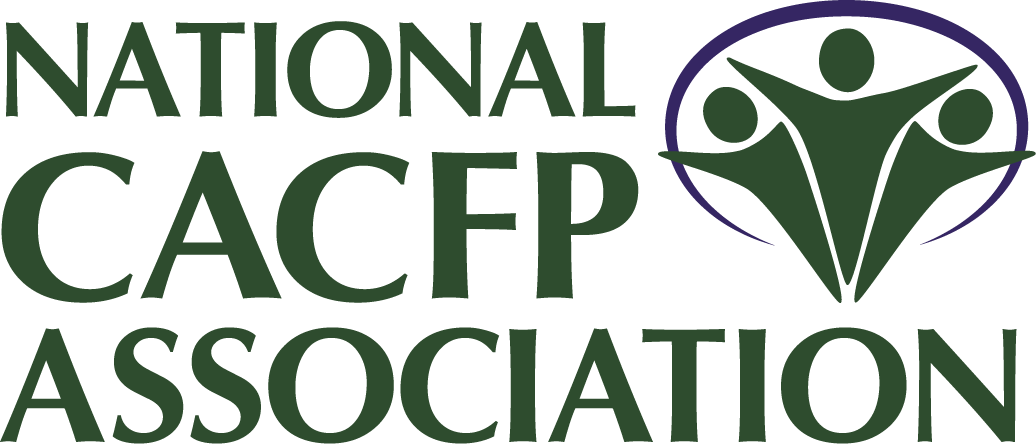





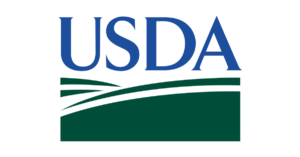


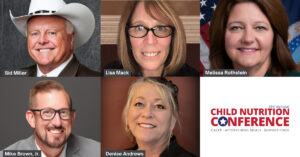



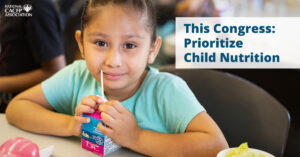



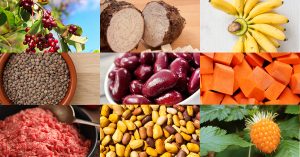

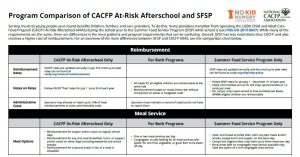


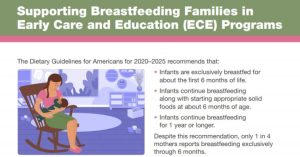








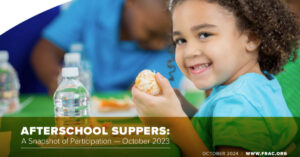
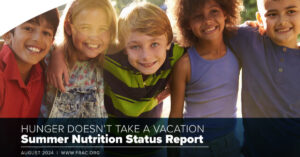





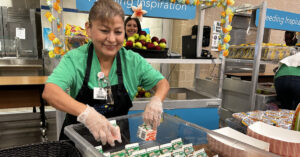
USDA Request for Information: Grain-Based Desserts & High-Protein Yogurt
On December 26, 2024, the USDA Food and Nutrition Service released a request for information (RFI) to help inform future policy, guidance, and technical assistance related to grain-based desserts and high-protein yogurt crediting in Child Nutrition Programs (CNPs). This is not a proposed rule, USDA is simply seeking additional information before moving forward with any rulemaking or future policy decisions.
Read More